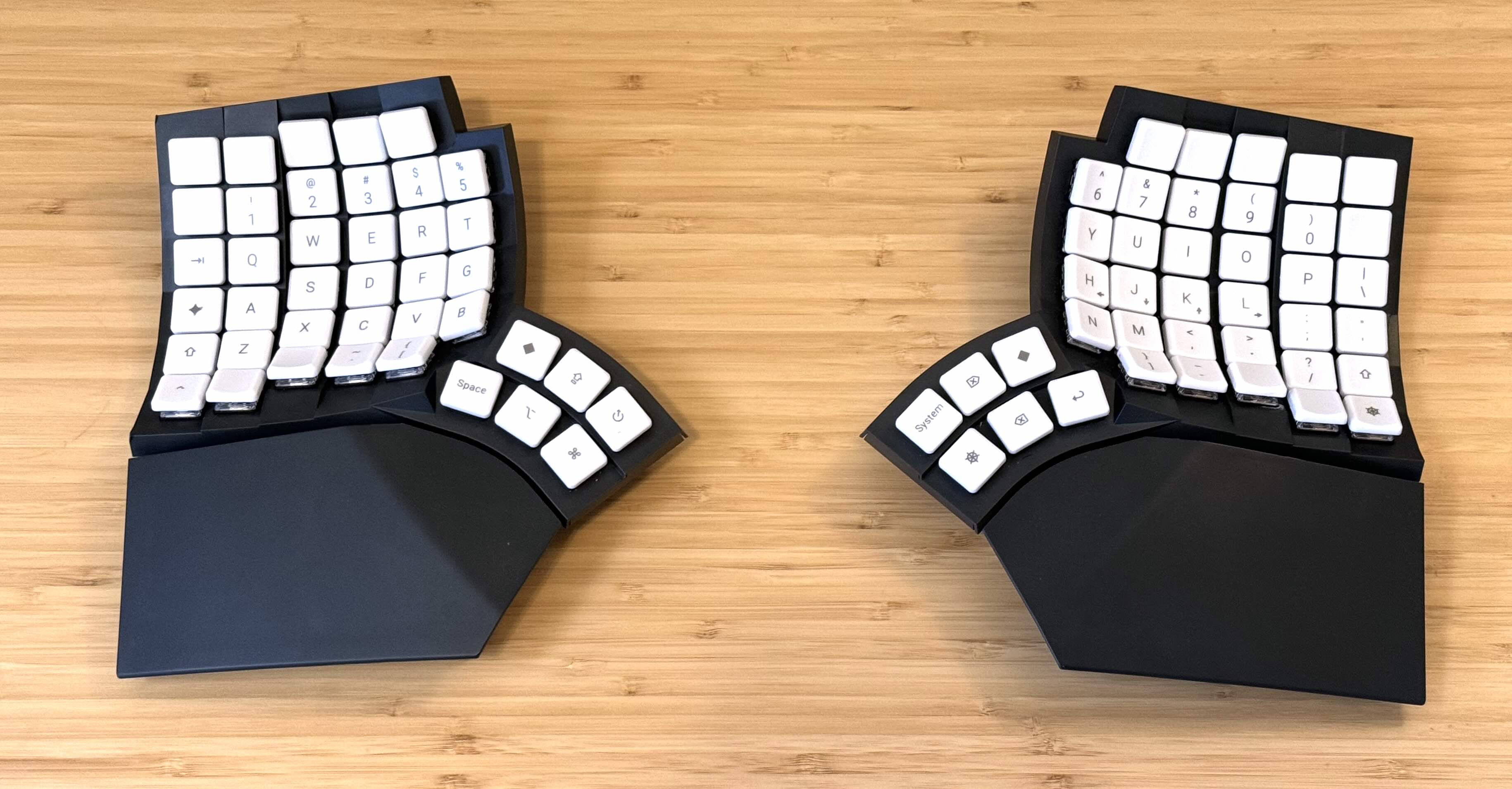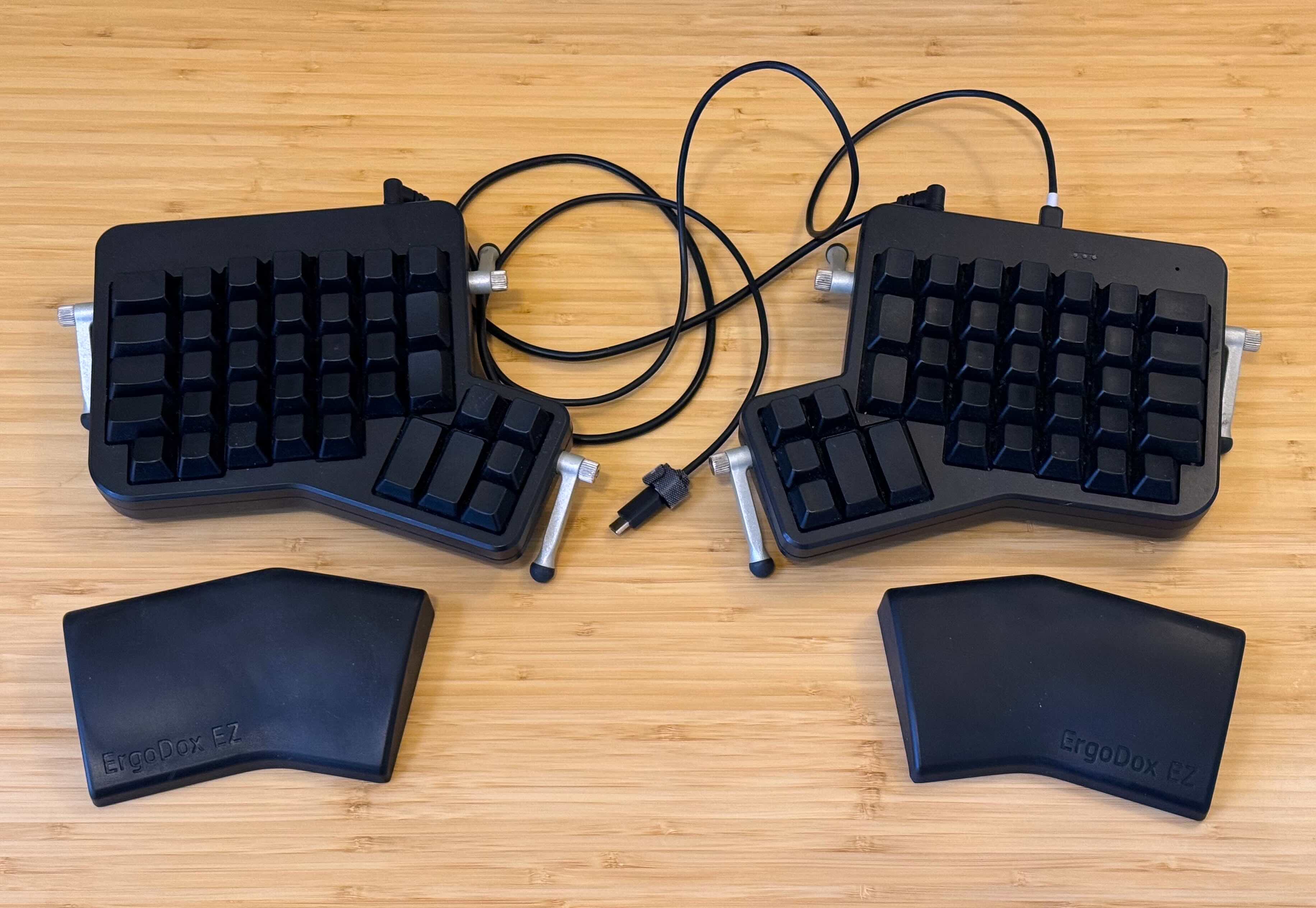Glove80 Keyboard Review
I bought myself one of these:

I previously used (and adored) one of these:

This post is a review of the Glove80 with frequent comparisons to the ErgoDox, since it was my baseline for years.
Sections
Feel
-
The housing is nicely minimalist, with no chin or forehead.
I appreciate this type of minimalism. Large expanses of empty housing like on a regular keyboard, or even the thick (vertically) and slightly wider (horizontally) housing on an ErgoDox makes it feel like an ungainly behemoth in comparison. This does have the unintended side effect of making the carrying case feel even more enormous than it already objectively is. (More on that later.)
-
The halves are so light that they don’t dampen vibrations very well.
This is relative and not terribly noticeable until you switch back to another keyboard that does. It’s a bit like being in a room that echoes slightly and not noticing until you go to a room that dampens echoes properly.
-
The low profile keys are quieter and a little mushier than mechnical keyboards with keys that bottom out.
The keys are way less satisfying to strike than the heavy bottoming-out you get on more standard mechanical keyboards like the ErgoDox. Since they don’t bottom out, using non-clicky switches will make the keyboard almost silent, which is a nice option if you’re into that. If you aren’t, consider using clicky switches if you’re not normally the type to.1
-
The integrated wrist rests are slippery and too small for those with large hands.
My palms dangle off the near edge of the wrist rests. This would be tolerable, but not great, except that they’re also pretty smooth so I’m constantly aware of my hands’ positioning in order to keep them from slipping off the near edge. I actually use the huge rubber brick wrist rests that came with the ErgoDox, which I love, and have disconnected the integrated rests. It’s a shame, because having exactly two pieces in total to wrangle would be really nice.
Build Quality
-
The housing design is prone to damage and seems to be made of relatively soft plastic.
I accidentally dropped one half a couple inches onto the desk and now there are permanently dulled corners with obvious damage. I don’t know why they didn’t bevel it like the ErgoDox to avoid this kind of damage. Pieces of the case aren’t completely flush with one another, though that’s only on the bottom where it’s usually out of sight.
-
The low profile switches and keycaps rattle slightly when you move the keyboard around.
The rattling only happens when moving it around, not when typing, but every time I pick it up to pack it it reminds me that it feels a little cheap. The ErgoDox does not rattle.
-
The carrying case that it comes with is very nice, if bulky.
The two halves fit very snugly into their molded holders and there’s a little room to spare for replacement parts and the relevant tools (like the keycap puller). I would not trust the keyboard to survive unprotected in a backpack or duffel, so the case is a welcome addition. On the other hand, the ErgoDox is indestructible and is therefore in some ways easier to travel with, despite all the associated bits.
-
The switches (and PCB?) are easily broken when replacing keycaps.
I broke one within a week by pulling out the keycaps too hard (which, to be fair, they warn you about). The keycaps really grip the switches and can jostle the switches around when being replaced, and unlike the ErgoDox the switches aren’t hot-swappable. It was a two-week affair to buy replacements and get a friend to solder it on, but it broke again within a month (PCB damage?) so I just stopped using that location. I broke a couple switches on my ErgoDox but never had to change my keymap to compensate since they could be hot-swapped.
Layout
-
The concavity takes a while to get used to, but makes so many keys available.
This is the first concave keyboard I’ve owned. It wasn’t difficult to get passably efficient, but it took a couple months before I stopped hitting adjacent keys by accident because they were closer than I was used to. In exchange, every finger gets comfortable access to 5 keys (doubled, for the index/pinky, them being on the edge) compared to the 3-4 on the ErgoDox.
-
The per-finger curvature and offset is excellent, excepting the pinky which should be more curved.
For the index/middle/ring fingers, all keys feel equally reachable without any preference for the middle finger (it being longer). The pinky is alright, but the second-from-top row is a stretch for it. I would have preferred they curve the pinky column more aggressively.
-
The thumb clusters give only three keys for regular use, but the other three are still comfortable to reach.
The lower row of thumb keys seems to be intended as the primary one. The upper row requires a small shift of your whole hand to strike fully, though you can graze the innermost upper row key without doing that. The top row is still useful, just for less-frequent keys. The three primary keys are as comfortable as those on the ErgoDox.2
-
One fewer column on the inner edge is not a problem.
I liked the big 1.5u keys on the inner columns of the ErgoDox because I could lift my hand and slap them with minimal precision. They were useful for symmetric, rare keys like brackets. The Glove80 takes this away, but since many more keys are reachable with the concavity, you can just bind those keys to the bottommost row, which is the most awkward but still way more reachable than those inner columns were.
-
The top row is only useful for rarely-used keys.
It’s too far, except for maybe the middle finger. That’s probably why it defaults to function keys.
Convenience
-
The wireless inter-keyboard connection is flawless.
In three months of using the keyboard every day, I have only had the two halves unable to communicate with each other once when I made a mistake while flashing firmware. It just works.
-
Having four Bluetooth connections makes it easy to use my keyboard everywhere.
I have three computers that I use this keyboard with regularly, so having a dedicated connection for each I can switch between with a single keystroke allows me to use my preferred keyboard with a minimum of fuss. The four-color status indicators are a nice bonus too.
-
Battery life is good but not incredible.
I’m used to a wired keyboard, so having any battery life to worry about at all is a downgrade. The battery life is measured in weeks, which is long enough to not be a problem but feels short compared to e.g. my mouse, whose battery life is measured in months. I would have preferred a heavier keyboard for unrelated reasons, so adding that weight with a larger battery would have been a win-win in my mind.
-
USB-C yes please.
No proprietary USB A Logitech dongles, no ErgoDox USB mini-B nonsense (that’s right: not micro-B; do you even remember mini-B?). Everything in my life must be USB-C.
Customization
-
ZMK firmware is a big step up from QMK.
ZMK was significantly easier for me to pick up and run with than QMK. In particular, it’s much more composable, with a strong macro system that allows combining a library of “behaviors” in infinite ways. ZMK is still under active development but already has all the important core features (up to and including mouse support!), and if you’re already familiar with C it’s clearer how to follow the examples to add custom behavior.
-
The extra Windows/Linux/Mac/”nerd” keycap sets are a nice touch.
The manufacturer sells keycaps with the Mac command symbol, Tux the penguin, Vim-style HJKL, etc. As you can see in the picture at the top, I currently use a mish-mash of symbols from different places, which I like. I don’t know how hard it is to find custom keycaps that fit these switches, though the switches themselves seem to be a little hard to find.
-
The switches are soldered, so make the right choice the first time.
I think I would have preferred clicky switches, but I can’t change them now with resoldering every single key, which sounds like a recipe for breakage. (Well, more than I already broke it by replacing some keycaps.)
-
The manufacturers are cagey about sharing hardware diagrams despite advertising third-party hardware customizations on the site.
I wanted to try 3D printing extra-long integrated wrist rests for my large hands, but while I did get a quick response on the manufacturer’s Discord3 when asking for the necessary measurements to properly line up the screw holes, they clearly did not want to share anything specific nor admit that they didn’t want to share anything specific. It quickly became radio silence.
Conclusion
The Glove80 resolves all of the ErgoDox’s issues with bulk, layout and accessories while keeping (or providing slight upgrades to!) most of the ErgoDox’s comfort and customizability features. It’s clearly trying to appeal to both average users and keyboard hackers, which sometimes ends up in tradeoffs favoring the average user, such as portability over big clacky keys. It’s noticeably less robust than the ErgoDox, and may not be as comfortable if you have large hands.
If the Glove80 is under consideration for your first serious ergonomic keyboard, buy it, though note that learning a split, concave and columnar layout without any prior experience takes a while.
If you already have a keyboard collection, this is definitely a worthy addition.
If you’re attracted to mechnical clackfests but want something that won’t give you instant RSI, you might be better of with the ErgoDox or something in that family.
For some more opinions, check out the very quantitative RTINGS review. If you’re into crazy keymap customization, check out this extremely detailed walkthrough of someone’s keymap.
Updated 2025-06-25: mouse keys are now fully supported by ZMK.
-
The Glove80 uses Kailh Choc v1 switches, which are surprisingly hard to find. I’m guessing from the “v1” that this is an older model. They aren’t listed on the Kailh site at all and I only found a few places online that sold them. ↩
-
I don’t understand why the ErgoDox even bothers with more than the three lower keys. The others are so unreachable as to be completely useless and I never bound them to anything, despite experimenting with some options. ↩
-
Ugh, I miss regular forums for this type of community. ↩